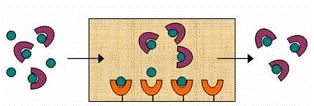Department of Chemistry
Document Type
Article
Date of this Version
10-2007
Citation
Published in final edited form as: Clin Chim Acta. 2007 October ; 385(1-2): 48–60. doi:10.1016/j.cca.2007.06.011. Version presented here is from NIH PubMed Central.
Abstract
Background—Non-enzymatic glycation of human serum albumin (HSA) is associated with the long-term complications of diabetes. We examined the structure and location of modifications on minimally glycated HSA and considered their possible impact on the binding of drugs to this protein.
Methods—Minimally glycated and normal HSA (used as a control) were digested with trypsin, Glu-C or Lys-C, followed by fractionation of the resulting peptides and their analysis by matrixassisted laser desorption/ionization mass spectrometry (MALDI-TOF MS) to determine the structures and locations of glycation adducts.
Results—Several specific lysine and arginine residues were identified as modification sites in minimally glycated HSA. Residues K12, K51, K199, K205, K439 and K538 were found to be modified through the formation of fructosyl-lysine, while the modification of K159 and K286 involved the formation of pyrraline, Nε-carboxymethyl-lysine respectively. Lysine K378 was found to give Nε-carboxyethyl-lysine in some forms of glycated HSA but fructosyl-lysine in other forms. Residues R160 and R472 produced a modification based on Nε-(5-hydro-4-imidazolon-2-yl) ornithine. Lysine R222 was modified to produce argpyrimidine, Nε-[5-(2,3,4-trihydroxybutyl)-5- hydro-4-imidazolon-2-yl]ornithine or tetrahydropyrimidine.
Conclusions—With the exception of K12, K199, K378, K439 and K525, all of the observed sites of modification for minimally glycated HSA were new to this current study. The fact that many of these glycation-related modifications are located at or near known drug binding sites on HSA explains why some differences have been previously noted in the binding of certain drugs to normal vs glycated HSA.



Comments
Copyright Elsevier Inc. Used By Permission.